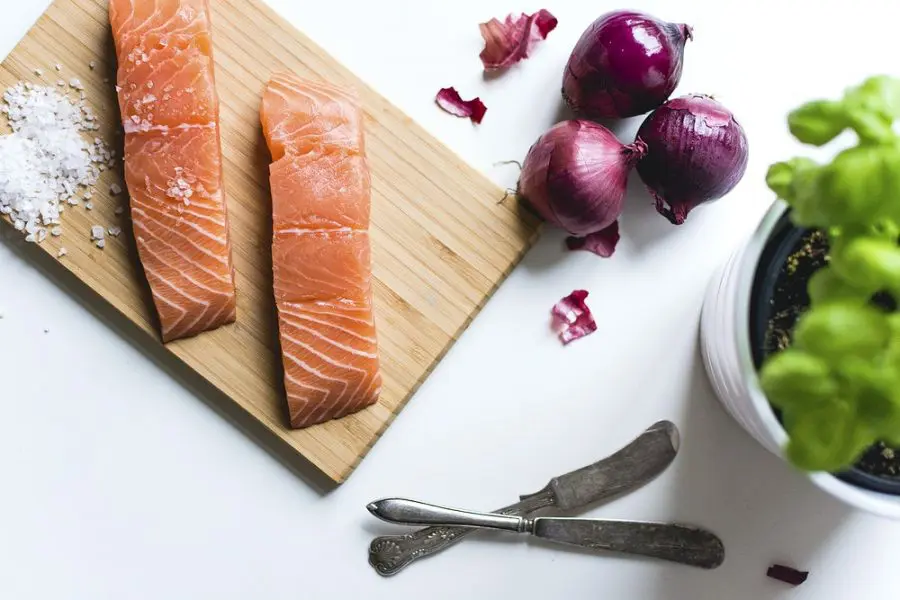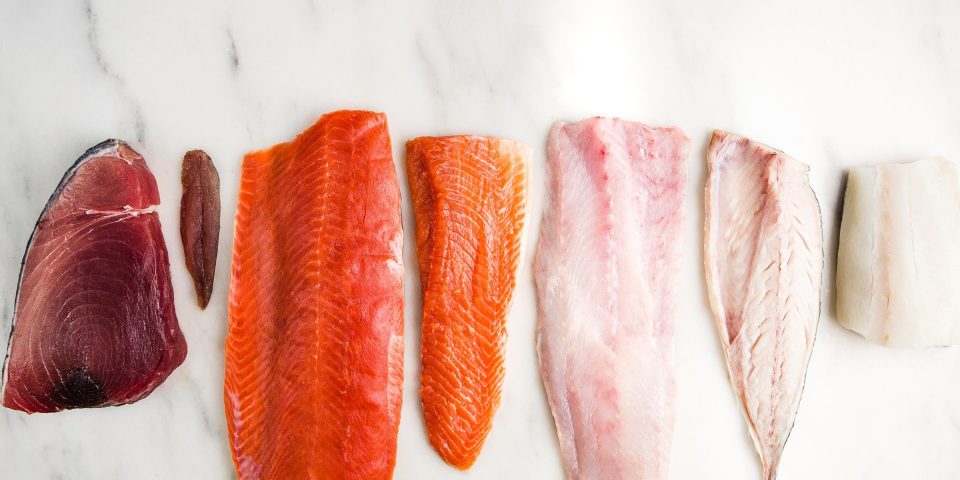What Does Salmon Taste Like?

While we are all familiar with the taste of cod or tuna, there is still a very long list of fish and seafood items that beg the question: what do they taste like? There are too many types of fish out there to be able to give you a comprehensive list, but what we can do is to narrow it down and make it easier to understand.
Today we will focus on salmon in particular. A very famous and well-loved fish, salmon is very peculiar and hard to define, but we will try our best. The taste and texture of this one that varies widely depending on the species, farming method, time of year, and your cooking approach, but generally all salmon has a high fat content and thus has a rich, oily taste.
Salmon is a large fish that can weigh up to 30 kilos and measure more than a meter and a half in length. Its skin is thick, bluish gray with silver on its belly, and dark spots on the head and back. Taste-wise it is very aromatic and a bit oily.
History of Eating Salmon
The Greeks and Romans were great consumers of salmon, but it was the people of northern Europe who valued it most. Salmon was very abundant in all rivers until the 18th century.
Later, the construction of dams, pollution, and overfishing almost made it disappear. Today, farming makes it possible for it to reach our local markets at lower prices.
The most common types of salmon is the Atlantic salmon. Less common are Alaska Red salmon, North Pacific pink salmon and Keta. In Spain the first salmon of the season to get fished is famous and very expensive when put up for auction. For a 5 kilo piece you can pay up to 14,500 euros!
Salmon Coloring
Salmon is called an oily fish, mostly due to its high percentage of good saturated fats. It is a full-flavored fish with a very colorful flesh, ranging from orange to dark red and it has a very distinctive flavor profile.
If you aren’t well-versed in the art of fish, we have a very simple guide for you to remember the next time you go grocery shopping or want to order at a restaurant. You can easily tell a fish’s flavour by the color of its uncooked meat.

The lighter or whiter the color, the milder the taste. Thus, if you are someone unsure about the taste of fish and want to slowly get used to it, we recommend the white meat variety. Above is the color spectrum to make it easier for you.
A little less known fact is that in its young days, salmon has a white meat . However, this does not mean it belongs to the white fish variety. Listen to me out on this one: It is the krill diet that changes the color of the meat to orange or pink. For farmed salmon, the color and taste of the fillet can be slightly different depending on the feed they receive.
Salmon Taste and Types
Now, about the taste. The higher the fat content of the fish, the more powerful the taste. This is also evident in species like King Salmon, who 100% deserves its name. Cold water increases the fat content, which also means an oilier texture and a more potent taste. A diet consisting of smaller, saltier fish is another factor contributing to the rich flavor of salmon.
The Chum or Dog Salmon is the best for those who don’t like the intense fish taste. It is also ideal for recipes like curries or chowder.

Pink Salmon is the most common type of salmon in the Pacific. It has a lower fat percentage and has a lighter colored flesh.

Red Salmon on the other hand has a stronger taste, rich texture, and a vivid red flesh. If you like the taste of salmon, this is the best option for you.
You can even call this the true salmon taste

The King Salmon that we mentioned previously is the biggest type of salmon in the world. According to many, it also has the best taste, though it is less intense than that of Red Salmon. When ocean-caught, you are guaranteed to get the full experience from a flavor perspective.

How to Cook Salmon
This will vary wildly depending on the type of salmon that you are dealing with. For Pink Salmon you get the best results by frying or roasting it; Red Salmon works excellently in sushi and sashimi; and Atlantic Salmon, the most versatile of them all, can be oven-baked, seared, pan-fried, grilled, boiled, basically anything you can think of.

When prepared the right way, salmon competes with any slab of quality steak served in gourmet restaurants. This is one of the reasons why it is also one of the most expensive types of fish. The good news is that, while indeed a bit costly, salmon is one of the healthiest fish to eat, especially wild-caught salmon.
Salmon Recipes
Check out our delicious salmon recipes provided by top chefs from all over the world:
- Mahogany Salmon Marinade
- Prosciutto Wrapped Salmon with Wilted Spinach & Lemon Beurre Blanc
- Fettuccine with Salmon & Asparagus in Lemon and Dill Oil
- Laxpudding: Swedish Salmon & Potatoes Bake
- Salmon Tomato Pasta (No Cream)
- Marinated Salmon w/ Wasabi-Cucumber Salad & Avocado Purée
How to Make Salmon Taste Milder
One of the best methods for making salmon taste less fishy, so to speak, is to soak it in milk for around 20 minutes before you cook it.
The explanation? Milk has a protein that will bind to the fishy odor and extract it from the fillets, eliminating some of its potency. What is now left behind is a sweeter and cleaner-tasting salmon.
Other methods of masking the taste is to squeeze fresh lemon juice over your cooked fish, which also adds some freshness to a dish. Or, if lemon is not your thing, try making different sauces to go along with your fillets.
There are many sauces you can opt for. For example, you can make a brown sugar and honey one to brush over the meat before you cook it. Many people have said that this improves the flavor and makes it easier to eat.
Another recipe is with Greek yogurt and fresh dill along with a pinch of garlic powder and a squeeze of lemon juice. Pour it over the finished dish and enjoy!
How to Tell When Salmon is Bad?
Everyone knows freshness is essential when it comes to our health. Fish in particular are fragile and the quality of their meat deteriorates quicker than that of other species. Since it is essential to know how to spot fresh fish, here are some tips:
First, discard every leftover fish that has not been refrigerated properly or that is older than 3 days.

Eye cloudiness is a good indicator of a fish’s freshness. The eyes should be clear, otherwise it means that it was caught more than 5 days ago and it has already started to go bad.
Look out for an ammonia smell. Always smell raw salmon to see if anything is off. If the meat has a strong ammonia odor then it is already in a bad state. When it is fresh, salmon does not smell particularly strong.
Another sign that salmon is in bad shape is the presence of a whitish sheen on top of the meat. If it looks slimy, it means that you need to throw it away.
And there you have it. I hope that this guide has been helpful and will come in handy when you are in search of good fish the next time you go grocery shopping.

